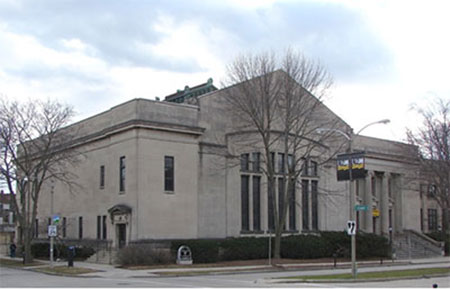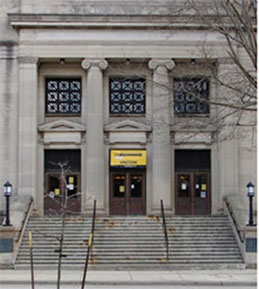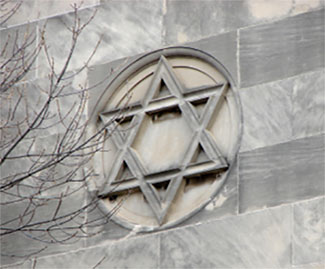10. Emanu-El Synagogue, 1922
Now the Helene Zelazo Center for the Performing Arts, U.W.-Milwaukee
2419 East Kenwood Boulevard (at Stowell Avenue)
Architects: Robert Messmer and Brother
This former synagogue is associated with two Reform Jewish congregations, B’ne Jeshurun and Emanu-El. In 1856, there were about 200 Jewish families in Milwaukee, organized into three synagogues. Rabbi Isaac Wise of Cincinnati, the founder of American Reform Judaism, visited Milwaukee in that year. In response to the advocacy of Rabbi Wise for changes in Jewish religious practice, two of the three congregations merged to form B’ne Jeshurun, the city’s first Reform Jewish congregation.
In 1869, a small group left B’ne Jeshurun and founded Congregation Emanu-El, seeking a more distinctly Reform style of worship. In contrast to B’ne Jeshurun, services at Emanu-El were conducted in English from the time of the congregation’s founding, even though the original members were German immigrants and German was still widely spoken throughout the city. Congregation Emanu-El built a synagogue on State Street at Broadway in 1871-72, which served for fifty years prior to construction of the synagogue on Kenwood Boulevard in 1922.
The two congregations reunited in 1927, prompted in part by the fact that the B’ne Jeshurun Synagogue at Kilbourn Avenue and 10th Street was slated for demolition to make way for the new county courthouse. The name of the synagogue was changed at that time to Emanu-El B’ne Jeshurun, incorporating the names of both of the original congregations. This was the Milwaukee area’s only Reform Jewish congregation from the time of the merger until the formation of new suburban congregations after World War II.
The later decades of the twentieth century saw an increasing portion of the congregation’s membership leaving the city for the northern suburbs. In response, the congregation bought a 10-acre parcel in River Hills in 1995 and built a new religious school and synagogue. The building on Kenwood Boulevard was sold to the Milwaukee campus of the University of Wisconsin a few years later. Since that time, the university has used the building for its performing arts programs.
Robert and Henry Messmer, partners in the architectural firm that designed the synagogue, were sons of Henry A. Messmer, one of the city’s early architects. Robert Messmer, born in 1870, apprenticed in his father’s office and later became a partner in the firm of Henry Messmer and Son. The firm continued under that name for more than a decade after the elder Henry Messmer’s death in 1899. Henry Messmer, Jr. worked for the firm from about 1900, becoming a partner with his older brother in 1911. At that time, the firm’s name was changed to Robert Messmer and Brother. A third brother, John Messmer, also worked for the firm as a construction superintendent.
The building’s exterior is a restrained example of neoclassical design, with embellishment mainly limited to the Ionic columns at the main entrance, pediments above the doors, and a Star of David in the front gable. The front and side walls are clad in Indiana limestone, cut to a smooth finish and laid with narrow mortar joints. This manner of stone construction de-emphasizes the individual pieces of stone and emphasizes instead the overall form, almost as if the entire building were cut from a single block of stone. The only other religious building in Milwaukee with this type of smooth stone finish is the former First Christian Science Church on Prospect Avenue at Curtis Place, built in 1907 and also in the neoclassical style.
The former synagogue’s main entrance on Kenwood Boulevard leads to a large lobby, with the original worship space to the east and a two-story wing to the west that included an assembly room, classrooms, and offices. The original design made the building relatively easy to convert to its present use with minimal alteration. Changes to the former worship space (now the concert hall) include an expanded stage, remodeling of the rear and side walls of the stage area to a plainer appearance, theater-style seating, and the installation of additional recessed lighting in the ceiling.
The large window on the Kenwood Boulevard façade, divided into 14 parts, retains the stained glass installed in 1931. There is a similar window on the opposite end of the former worship space. Both windows depict menorahs, Torah scrolls, and other symbols of the Jewish faith as well as some Hebrew script. Each window is 36 feet in width and 25 feet high at its highest point. They are among the largest stained glass windows in any pre-World War II place of worship in Milwaukee.
Sources:
Congregation Emanu-El: Golden Anniversary, 1869-1919. Congregation Emanu-El, 1919.
Founder Shabbat: Congregation Emanu-El B’ne Jeshurun, November 28, 1980. Congregation Emanu-El B’ne Jeshurun, 1980.
Fromstein, Ruth. In This Place: Congregation Emanu El B’ne Jeshurun’s First 150 Years. Author House, c. 2006.
Messmer, Robert and brother, architects. Blueprints of drawings for Emanu-El Synagogue, dated July 12, 1920. Wisconsin Architectural Archive, Milwaukee Central Library, drawing set 27-7.



